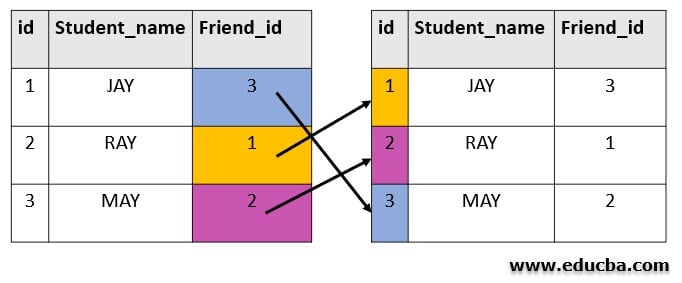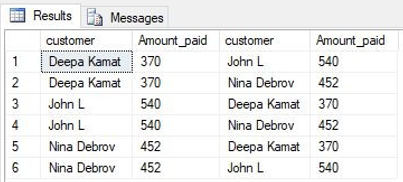Updated March 27, 2023

Introduction to SQL Self Join
A self-join is a Structured Query Language (SQL) statement in which a table is joined with itself, an inner join is performed on a single table with itself, particularly in cases when comparisons have to be made between the records of the same table to determine a relationship or in the cases when the table has a FOREIGN KEY which references its own PRIMARY
Syntax
The generic syntax for working with SQL SELF Join is as follows :
SELECT t1.column_name, t2.column_name
FROM table_name1 t1, table_name1 t2
WHERE t1.common_filed = t2.common_field;Parameters in SQL Self Join
The different parameters used in the syntax are :
- SELECT t1.column_name, t2.column_name: It is used to select the required data from the database. Here, t1.column_name is the column from the table’s instance t1. t2.column_name is the column from the table’s instance t2.
- FROM table_name1 t1, table_name1 t2: It is used to specify the source from which data has to be fetched. Since in self-join, we perform an inner join on a single table. We create two instances of the table as t1 and t2.
- WHERE t1.common_filed = t2.common_field: It is used to specify the conditions to filter records.In self join we will be mentioning the condition on which the two instances of the table, namely t1 and t2 will join. This is the common field on which tables will join.
Of the above-mentioned parameters, all the parameters are mandatory. You may use GROUP BY, ORDER BY and HAVING clauses based on your requirement.
How does SQL Self Join work?
Self-join is mostly used in cases where we have :
- Hierarchical Relationships
- Sequential Relationships
Self join works by joining a table with itself on a defined condition. For example, let’s assume that we have a group of students and they have a best friend relationship with some other student in the same table and we want to know the name of the student and his friend.
| Id | Student_name | Friend_id |
| 1 | JAY | 3 |
| 2 | RAY | 1 |
| 3 | MAY | 2 |
- Now, in order to get the name of each student along with his friend, we can perform a self-join which will join the table something like this on the condition that friend id is equal to student_id.
- The resultant table will look something like this :
| Id | Student_name | Friend |
| 1 | JAY | MAY |
| 2 | RAY | JAY |
| 3 | MAY | RAY |
- Going ahead we will be discussing the above-mentioned self join in great detail. In order to demonstrate and explain the Self join in SQL effectively, we will be using the following table. This table is made for an e-commerce website. The table contains customer id, names, city, and the country to which they belong. The schema for the above mentioned “customers” table is :
- Number of Records: 15
| Customers |
| ID(primary key) |
| Customer |
| City |
| Country |
- Let’s have a look at the records in the customer’s table. So that later, we can understand how self join is helpful:
| ID | Customer | City | Country | Items_purchased | Amount_paid |
| 1 | Peter King | Manchester | England | Books | 120 |
| 2 | Priya Krishna | New Delhi | India | pen | 50 |
| 3 | Jim Halpert | Manchester | England | pencil | 43 |
| 4 | Michael Scott | New York | USA | Books | 250 |
| 5 | Harvey Spector | Birmingham | England | pencil | 100 |
| 6 | Deepa Kamat | Mumbai | India | Books | 370 |
| 7 | Anita Desai | London | England | pencil | 50 |
| 8 | Rachel Zane | Michigan | USA | pen | 70 |
| 9 | Pretoria John | Canberra | Australia | pen | 190 |
| 10 | John L | Budapest | Hungry | Books | 540 |
| 11 | Justin Green | Ottawa City | Canada | pen | 65 |
| 12 | Babita Ghosh | Kolkata | India | pencil | 75 |
| 13 | Krish Pratt | London | England | eraser | 30 |
| 14 | Elizabeth Blunt | London | England | pencil | 340 |
| 15 | Nina Debrov | Amsterdam | Netherlands | Books | 452 |
Examples to Implement in SQL Self Join
Here are a few examples to illustrate self joins in SQL.
Example #1
Find the pairs of customers who belong to the same city.
Code:
SELECT t1.Customer AS Customer1, t2.Customer AS Customer2, t1.City
FROM Customers t1, Customers t2
WHERE t1.ID <> t2.ID AND t1.City = t2.City
ORDER BY t1.City;Output:
Explanation: In the above example, the self joins first joins the two instances of customers t1 and t2. It’s like a cartesian product of two tables. Then it filters the given rows based on the criteria that IDs of two customers should not be the same and they should belong to the same city. Finally, after filtering, the resulting records are sorted in ascending order by the city.
Example #2
Find customers who belong to the same city and have shopped for pencils
Code:
SELECT t1.Customer AS Customer1, t2.Customer AS Customer2, t1.City
FROM Customers t1, Customers t2
WHERE t1.ID <> t2.ID AND t1.City = t2.City AND t1.Items_purchased = 'pencil'
AND t2.Items_purchased = 'pencil'
ORDER BY t1.City;Output:
Example #3
Find the customers who belong to the same country and have shopped for less than 100
Code:
SELECT t1.Customer AS Customer1, t2.Customer AS Customer2, t1.Country, t1.Amount_paid , t2.
Amount_paid
FROM Customers t1, Customers t2
WHERE t1.ID <> t2.ID AND t1.City = t2.City AND t1.Amount_paid < 100 AND
t2.Amount_paid < 100
ORDER BY Country;Output:
Example #4
Find the pair of customers who have spent more than 300 on Books
Code:
SELECT t1.customer, t1.Amount_paid,t2.customer, t2.Amount_paid
FROM customers as t1 , customers as t2
WHERE t1.Items_purchased = t2.Items_purchased
AND t1.Items_purchased = 'Books' AND t2.Items_purchased = 'Books'
AND t1.Amount_paid > 300 and t2.Amount_paid > 300 AND t1.ID <> t2.ID
Order by t1.Customer;Output:
- When performing joins in SQL, we should always try to use table aliases which are abbreviations of the given tables. This helps in writing beautiful pieces of code.
Conclusion
SQL self-join is a statement that is used to join a table on itself. We should use it when we want to find relationships between records in the same table.
Recommended Articles
We hope that this EDUCBA information on “SQL Self Join” was beneficial to you. You can view EDUCBA’s recommended articles for more information.





